
As 2022 draws to a close, the Threat Research Team at McAfee Labs takes a look forward—offering their predictions for 2023 and how its threat landscape may take shape.
This year saw the continued evolution of scams, which is unlikely to slow down, as well as greater adoption of Chrome as an operating system. It also saw the introduction of AI tools that are easy and accessible to virtually anyone with a phone or laptop, which will continue to have significant implications, as will the fluctuating popularity of cryptocurrency and the emergence of “Web3.”
Advances such as these have set the stage for 2023, which will continue to reshape our interactions with technology—advances that bad actors will try to exploit, and in turn, us.
Yet as the threat landscape continues to evolve, so do the ways we can protect ourselves. With that, we share McAfee’s threat predictions for 2023, along with insights and advice that can help us enjoy the advances to come with confidence.
By Steve Grobman, Chief Technology Officer
Humans have been fascinated by artificial intelligence (AI) for almost as long as we’ve been using computers. And in some cases, even fearful of it. Depictions in pop culture range from HAL, the sentient computer from 2001: A Space Odyssey to Skynet, the self-aware neural network at the center of the Terminator franchise. The reality of current AI technologies is both more complicated and less autonomous than either of these. While AI is rapidly evolving, humans remain at the heart of it, and whether it’s put to beneficial or nefarious use.
Within the last few months, creating AI-generated images, videos, and even voices are no longer strictly left to professionals. Now anyone with a phone or computer can take advantage of the technology using publicly available applications like Open AI’s Dall-E or stability.ai’s Stable Diffusion. Google has even made creating AI-generated videos easier than ever.
What does this mean for the future? It means the next generation of content creation is becoming available to the masses and will only continue to evolve. People both at work and at home will have the ability to create the AI-generated content in minutes. Just as desktop publishing, photo editing, and inexpensive photorealistic home printers created major advances that empowered individuals to create content that previously required a professional designer, these technologies will enable sophisticated outputs with minimal expertise or effort.
Advances in desktop publishing and consumer printing also provided benefits to criminals, enabling better counterfeiting and more realistic manipulation of images. Similarly, these emerging next-generation content tools will also be used by a range of bad actors. From cybercriminals to those seeking to falsely influence public opinion, these tools will empower scammers and propagandists to take their tradecraft to the next level with more realistic results and significantly improved efficiency.
This is especially likely to ramp up in 2023 as the U.S. begins the 2024 presidential election cycle in earnest. Globally, the political environment is polarized. The confluence of the emergence of accessible next-generation generative AI tools and what is sure to be a highly contested 2024 election season is a perfect storm for creating and distributing disinformation for political and monetary gain.
We’ll all need to be more mindful of the content we consume and the sources that it originates from. Fact-checking images, videos, and news content, something that’s already on the rise, will continue to be a necessary and valuable part of media consumption.
By Oliver Devane, Security Researcher
Cryptocurrency scams
In 2022 we saw several online scams making use of existing content to make crypto scams more believable. One such example was the double your money cryptocurrency scam that used an old Elon Musk video as a lure. We expect such scams to evolve in 2023 and make use of deep fake videos, as well as audio, to trick victims into parting ways with their hard-earned money.

The financial outlook of 2023 remains uncertain for many people. During these times, people often look for ways to make some extra money and this can lead them vulnerable to social media messages and online ads that offer huge financial gains for little investment.
According to the IC3 2021 report, the losses for financial scams increased from $336,469,000 in 2020 to $1,455,943,193 in 2021, this shows that this type of scam is growing by an enormous amount, and we expect this to continue.
Unfortunately, scammers will often target the most vulnerable people. Fake loan scams are one such scam where the scammers know that the victims are desperate for the loan and therefore are less likely to react to warning signs such as asking for an upfront fee. McAfee predicts that there will be a large increase in these types of scams in 2023. When looking for a loan, always use a trusted provider and be careful of clicking on online ads.
Metaverses such as Facebook’s Horizon enable their users to explore an online world that was previously unimaginable. When these platforms are in the early stages, malicious actors will usually attempt to exploit the lack of understanding of how they work and use this to scam people. We have observed phishing campaigns targeting users of these platforms in 2022 and we expect this to increase dramatically in 2023 as more and more users sign up for the platforms.
By Craig Schmugar, McAfee Senior Principal Engineer
More than 25 years ago, Windows 95 became the platform of choice not just for millions of users around the globe, but for malware authors targeting those users. Over the years, Windows has evolved, as has the threat landscape. Today, Windows 10 and 11 make up the majority of the desktop PC market, but thanks to the rise of the mobile Internet, device diversity has greatly evolved since the advent of Windows 95.
Over five years ago, Android overtook Windows as the world’s most popular OS and with this shift bad actors have been pursing alternative methods of attack. The ultimate vectors are those which impact users across a spectrum of devices. Email and web-based scams (some of which are outlined in the blog above) are as prolific as ever as these technologies are ubiquitous across desktop and mobile devices.
Meanwhile, other technologies span across desktop and mobile experiences as well. For Google, such cross-platform capabilities are highlighted by increased adoption of ChromeOS and a few underlying technologies. This includes 270 million active Android users and a 270% increase in Progressive Web Application (PWA) installations [https://chromeos.dev]. ChromeOS’ ability to run Android applications, combined with its wide-spread adoption, provides the climate for increased attention by those with ill intentions.
Similarly, adoption of PWAs provide bad actors with additional incentive to deliver deceptive and imposter attacks through this multi-OS channel, including ChromeOS, iOS, MacOS, and Windows.
Finally, on the heels of COVID restrictions that impacted schools in various countries, Google reported 50 million students and educators worldwide [https://chromeos.dev] using ChromeOS. Many users will be unaware of malicious Chrome extensions lurking in the Chrome Web Store.
All of this means that the stage is set for a marked increase in threats impacting Chromebook in the year to come. In 2023, we can expect to see Chromebook users among millions of unsuspecting victims that download and run malicious content, whether from malicious Android Apps, Progressive Web Apps, or Chrome Web Store extensions, users should be leery of popups and push notifications urging them to install untrusted apps.
By Fernando Ruiz, Senior Security Researcher
Editor’s Note: Web3? FOMO? If you’re already lost, you’re not alone. Web3 is a term some use to encompass decentralized internet services, technologies like Bitcoin and Non-Fungible Tokens (digital art that collectors can purchase with cryptocurrency). Still confused? A lot of people are. This New York Times article is a good primer on what is currently considered Web3.
As for FOMO, that’s just an acronym meaning the “Fear of Missing Out.” That nagging feeling, most often felt by extroverts, that others are out there having more fun than them and that they’re missing the party.
Whether you invest in cryptocurrency or just see the headlines on Twitter, no doubt you’ve seen that the price of cryptocurrency has sharply declined during 2022. These fluctuations are becoming more normal as crypto becomes even more mainstream. It’s very likely that the value of crypto will rise again.
When the last upturn in valuation happened near the start of the pandemic, the hype about crypto also skyrocketed. Suddenly Bitcoin and other cryptocurrencies were everywhere. Out of that, rose the concept of Web3, with more companies investing in new applications over blockchain (the technology that is the backbone of cryptocurrency).
McAfee predicts that the popularity of cryptocurrency will rise again, and consumers will hear much more about Web3 concepts like decentralized finance (DeFi), decentralized autonomous organizations (DAOs), self-sovereign identity (SSI) and more.
Some amateur investors, remembering the rapid rise of the value of Bitcoin earlier this decade, won’t want to miss out on what they think will be a great opportunity to get rich quick. It’s this group that bad actors will seek to exploit, offering up links or applications that play on these users’ crypto/Web3 FOMO.
As crypto bounces back and initial awareness of decentralization grows in the general population, consumers will begin to explore these Web3 offerings without fully understanding what they mean or what dangers they should be aware of, leaving them open to scams as they invest time and money into crypto or creating their own NFT content. These scams could entice users to click on a link or download an app that appears to legitimately interact with some blockchains, but in actuality:
Additionally, when consumers DO hold crypto, NFT, digital land, or other blockchain financial assets they are going to be targeted for more sophisticated threats that can drain their funds: smart contracts, exchanges, digital wallets, and synchronization services can all be associated with hidden authorizations that allow a third party (potentially a bad actor) to take control of the assets. It’s important that users read the terms and conditions of any app they download, especially those that will be accessing ANY type of financial institution or currency, whether traditional or crypto.
Social engineering will also continue to be a top entry point for cybercriminals. The complexity of the attacks will evolve as the technology does, which will require more preparation and understanding of how Web3 applications and tools work in order to safely interact with them.
What has emerged from the world of Web3 thus far, while exciting, has also expanded attack surfaces and vectors, which we expect to see grow throughout 2023 as Web3 evolves.
The post McAfee 2023 Threat Predictions: Evolution and Exploitation appeared first on McAfee Blog.
In December 2021, Google filed a civil lawsuit against two Russian men thought to be responsible for operating Glupteba, one of the Internet’s largest and oldest botnets. The defendants, who initially pursued a strategy of counter suing Google for interfering in their sprawling cybercrime business, later brazenly offered to dismantle the botnet in exchange for payment from Google. The judge in the case was not amused, found for the plaintiff, and ordered the defendants and their U.S. attorney to pay Google’s legal fees.
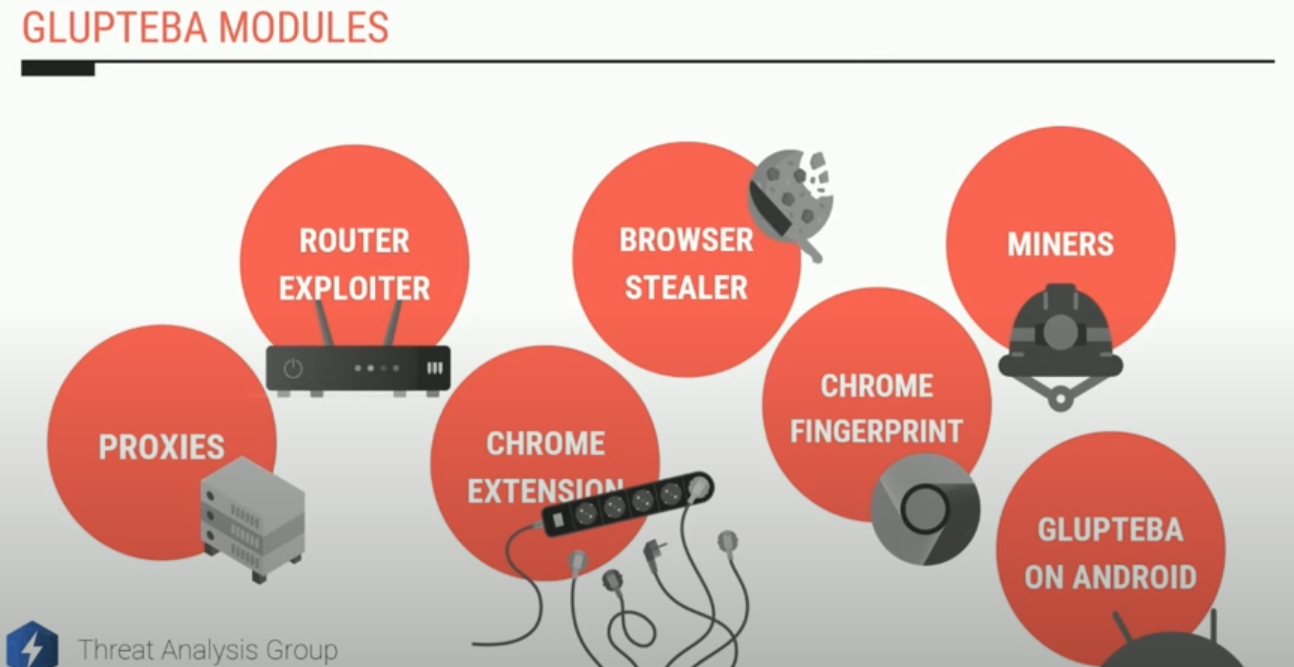
A slide from a talk given in Sept. 2022 by Google researcher Luca Nagy. https://www.youtube.com/watch?v=5Gz6_I-wl0E&t=6s
Glupteba is a rootkit that steals passwords and other access credentials, disables security software, and tries to compromise other devices on the victim network — such as Internet routers and media storage servers — for use in relaying spam or other malicious traffic.
Collectively, the tens of thousands of systems infected with Glupteba on any given day feed into a number of major cybercriminal businesses: The botnet’s proprietors sell the credential data they steal, use the botnet to place disruptive ads on the infected computers, and mine cryptocurrencies. Glupteba also rents out infected systems as “proxies,” directing third-party traffic through the infected devices to disguise the origin of the traffic.
In June 2022, KrebsOnSecurity showed how the malware proxy services RSOCKS and AWMProxy were entirely dependent on the Glupteba botnet for fresh proxies, and that the founder of AWMProxy was Dmitry Starovikov — one of the Russian men named in Google’s lawsuit.
Google sued Starovikov and 15 other “John Doe” defendants, alleging violations of the Racketeer Influenced and Corrupt Organizations Act (RICO), the Computer Fraud and Abuse Act, trademark and unfair competition law, and unjust enrichment.
In June, Google and the named defendants agreed that the case would proceed as a nonjury action because Google had withdrawn its claim for damages — seeking only injunctive relief to halt the operations of the botnet.
The defendants, who worked for a Russian firm called “Valtron” that was also named in the lawsuit, told Google that they were interested in settling. The defendants said they could potentially help Google by taking the botnet offline.
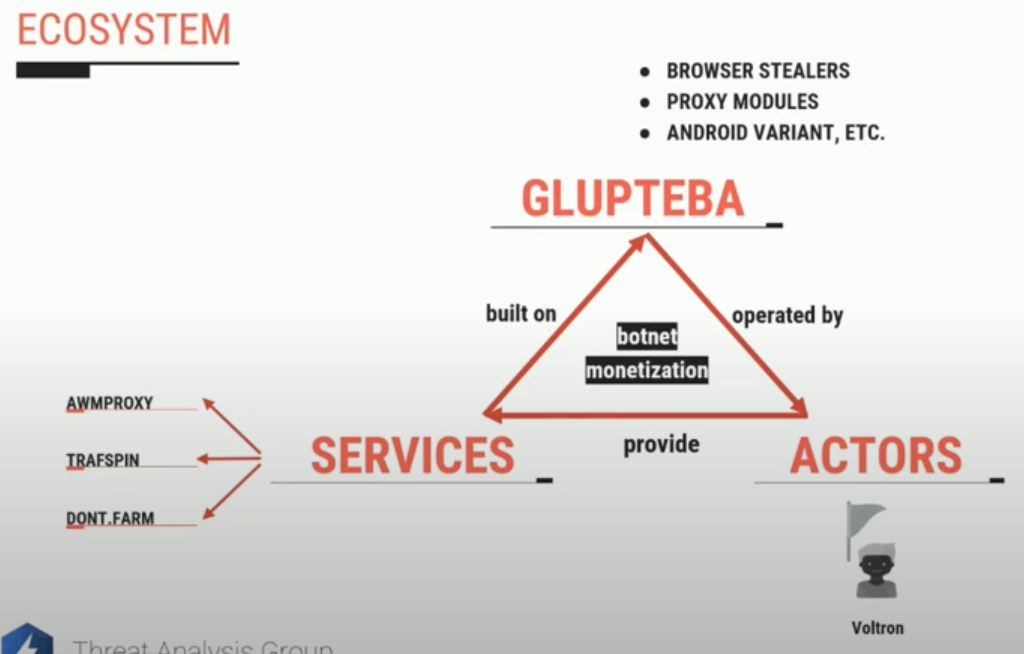
Another slide from Google researcher Luca Nagy’s September 2022 talk on Glupteba.
But the court expressed frustration that the defendants were unwilling to consent to a permanent injunction, and at the same time were unable to articulate why an injunction forbidding them from engaging in unlawful activities would pose a problem.
“The Defendants insisted that they were not engaged in criminal activity, and that any alleged activity in which they were engaged was legitimate,” U.S. District Court Judge Denise Cote wrote. “Nevertheless, the Defendants resisted entry of a permanent injunction, asserting that Google’s use of the preliminary injunction had disrupted their normal business operations.”
While the defendants represented that they had the ability to dismantle the Glupteba botnet, when it came time for discovery — the stage in a lawsuit where both parties can compel the production of documents and other information pertinent to their case — the attorney for the defendants told the court his clients had been fired by Valtron in late 2021, and thus no longer had access to their work laptops or the botnet.
The lawyer for the defendants — New York-based cybercrime defense attorney Igor Litvak — told the court he first learned about his clients’ termination from Valtron on May 20, a fact Judge Cote said she found “troubling” given statements he made to the court after that date representing that his clients still had access to the botnet.
The court ultimately suspended the discovery process against Google, saying there was reason to believe the defendants sought discovery only “to learn whether they could circumvent the steps Google has taken to block the malware.”
On September 6, Litvak emailed Google that his clients were willing to discuss settlement.
“The parties held a call on September 8, at which Litvak explained that the Defendants would be willing to provide Google with the private keys for Bitcoin addresses associated with the Glupteba botnet, and that they would promise not to engage in their alleged criminal activity in the future (without any admission of wrongdoing),” the judge wrote.
“In exchange, the Defendants would receive Google’s agreement not to report them to law enforcement, and a payment of $1 million per defendant, plus $110,000 in attorney’s fees,” Judge Cote continued. “The Defendants stated that, although they do not currently have access to the private keys, Valtron would be willing to provide them with the private keys if the case were settled. The Defendants also stated that they believe these keys would help Google shut down the Glupteba botnet.”
Google rejected the defendants’ offer as extortionate, and reported it to law enforcement. Judge Cote also found Litvak was complicit in the defendants’ efforts to mislead the court, and ordered him to join his clients in paying Google’s legal fees.
“It is now clear that the Defendants appeared in this Court not to proceed in good faith to defend against Google’s claims but with the intent to abuse the court system and discovery rules to reap a profit from Google,” Judge Cote wrote.
Litvak has filed a motion to reconsider (PDF), asking the court to vacate the sanctions against him. He said his goal is to get the case back into court.
“The judge was completely wrong to issue sanctions,” Litvak said in an interview with KrebsOnSecurity. “From the beginning of the case, she acted as if she needed to protect Google from something. If the court does not decide to vacate the sanctions, we will have to go to the Second Circuit (Court of Appeals) and get justice there.”
In a statement on the court’s decision, Google said it will have significant ramifications for online crime, and that since its technical and legal attacks on the botnet last year, Google has observed a 78 percent reduction in the number of hosts infected by Glupteba.
“While Glupteba operators have resumed activity on some non-Google platforms and IoT devices, shining a legal spotlight on the group makes it less appealing for other criminal operations to work with them,” reads a blog post from Google’s General Counsel Halimah DeLaine Prado and vice president of engineering Royal Hansen. “And the steps [Google] took last year to disrupt their operations have already had significant impact.”
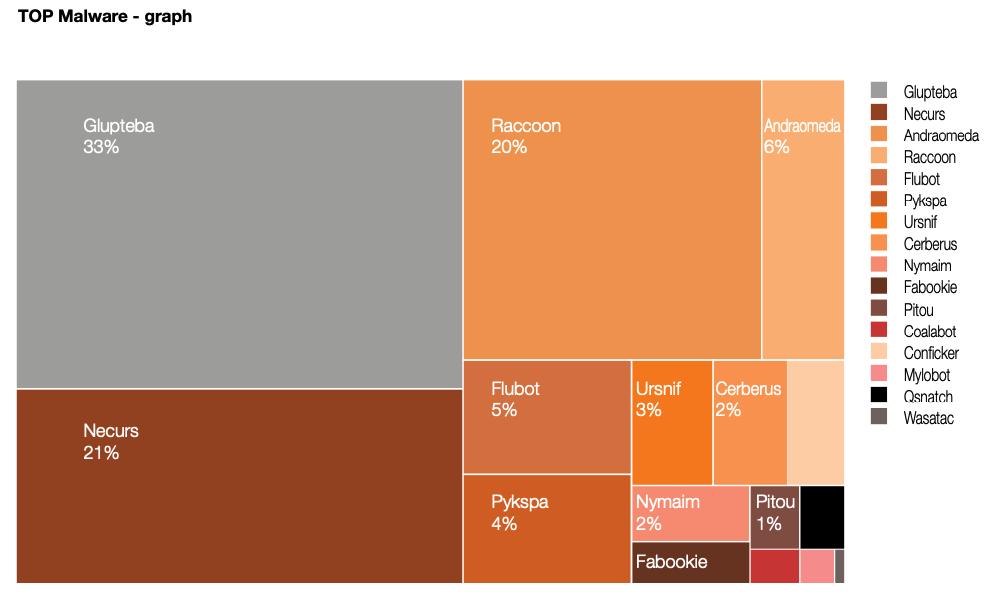
A report from the Polish computer emergency response team (CERT Orange Polksa) found Glupteba was the biggest malware threat in 2021.




A recent scoop by Reuters revealed that mobile apps for the U.S. Army and the Centers for Disease Control and Prevention (CDC) were integrating software that sends visitor data to a Russian company called Pushwoosh, which claims to be based in the United States. But that story omitted an important historical detail about Pushwoosh: In 2013, one of its developers admitted to authoring the Pincer Trojan, malware designed to surreptitiously intercept and forward text messages from Android mobile devices.
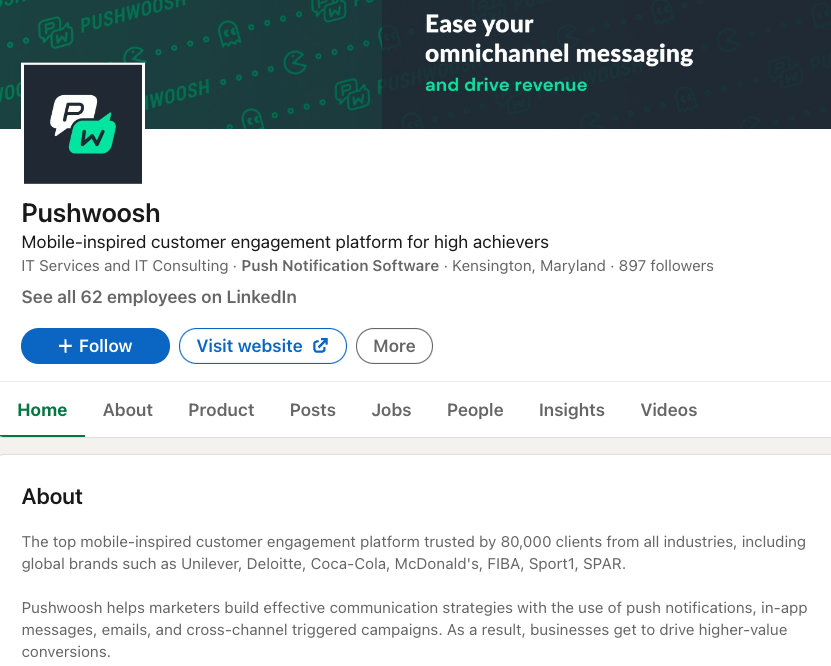
Pushwoosh says it is a U.S. based company that provides code for software developers to profile smartphone app users based on their online activity, allowing them to send tailor-made notifications. But a recent investigation by Reuters raised questions about the company’s real location and truthfulness.
The Army told Reuters it removed an app containing Pushwoosh in March, citing “security concerns.” The Army app was used by soldiers at one of the nation’s main combat training bases.
Reuters said the CDC likewise recently removed Pushwoosh code from its app over security concerns, after reporters informed the agency Pushwoosh was not based in the Washington D.C. area — as the company had represented — but was instead operated from Novosibirsk, Russia.
Pushwoosh’s software also was found in apps for “a wide array of international companies, influential nonprofits and government agencies from global consumer goods company Unilever and the Union of European Football Associations (UEFA) to the politically powerful U.S. gun lobby, the National Rifle Association (NRA), and Britain’s Labour Party.”
The company’s founder Max Konev told Reuters Pushwoosh “has no connection with the Russian government of any kind” and that it stores its data in the United States and Germany.
But Reuters found that while Pushwoosh’s social media and U.S. regulatory filings present it as a U.S. company based variously in California, Maryland and Washington, D.C., the company’s employees are located in Novosibirsk, Russia.
Reuters also learned that the company’s address in California does not exist, and that two LinkedIn accounts for Pushwoosh employees in Washington, D.C. were fake.
“Pushwoosh never mentioned it was Russian-based in eight annual filings in the U.S. state of Delaware, where it is registered, an omission which could violate state law,” Reuters reported.
Pushwoosh admitted the LinkedIn profiles were fake, but said they were created by a marketing firm to drum up business for the company — not misrepresent its location.
Pushwoosh told Reuters it used addresses in the Washington, D.C. area to “receive business correspondence” during the coronavirus pandemic. A review of the Pushwoosh founder’s online presence via Constella Intelligence shows his Pushwoosh email address was tied to a phone number in Washington, D.C. that was also connected to email addresses and account profiles for over a dozen other Pushwoosh employees.
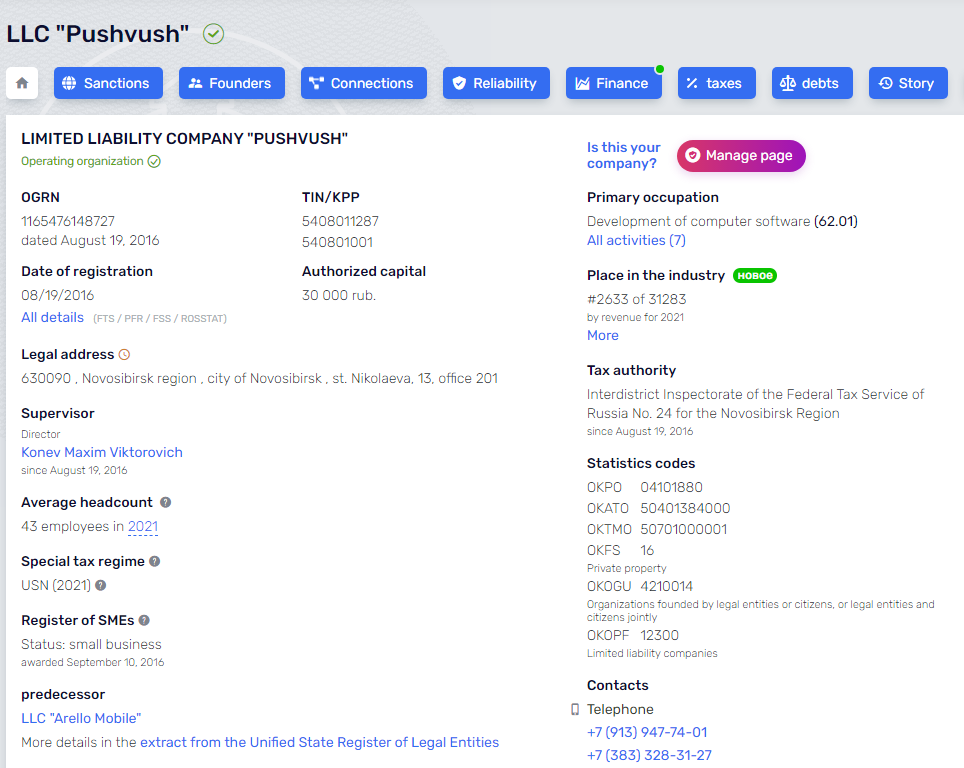
Pushwoosh was incorporated in Novosibirsk, Russia in 2016.
The dust-up over Pushwoosh came in part from data gathered by Zach Edwards, a security researcher who until recently worked for the Internet Safety Labs, a nonprofit organization that funds research into online threats.
Edwards said Pushwoosh began as Arello-Mobile, and for several years the two co-branded — appearing side by side at various technology expos. Around 2016, he said, the two companies both started using the Pushwoosh name.
A search on Pushwoosh’s code base shows that one of the company’s longtime developers is a 41-year-old from Novosibirsk named Yuri Shmakov. In 2013, KrebsOnSecurity interviewed Shmakov for the story, “Who Wrote the Pincer Android Trojan?” wherein Shmakov acknowledged writing the malware as a freelance project.
Shmakov told me that, based on the client’s specifications, he suspected it might ultimately be put to nefarious uses. Even so, he completed the job and signed his work by including his nickname in the app’s code.
“I was working on this app for some months, and I was hoping that it would be really helpful,” Shmakov wrote. “[The] idea of this app is that you can set it up as a spam filter…block some calls and SMS remotely, from a Web service. I hoped that this will be [some kind of] blacklist, with logging about blocked [messages/calls]. But of course, I understood that client [did] not really want this.”
Shmakov did not respond to requests for comment. His LinkedIn profile says he stopped working for Arello Mobile in 2016, and that he currently is employed full-time as the Android team leader at an online betting company.
In a blog post responding to the Reuters story, Pushwoosh said it is a privately held company incorporated under the state laws of Delaware, USA, and that Pushwoosh Inc. was never owned by any company registered in the Russian Federation.
“Pushwoosh Inc. used to outsource development parts of the product to the Russian company in Novosibirsk, mentioned in the article,” the company said. “However, in February 2022, Pushwoosh Inc. terminated the contract.”
However, Edwards noted that dozens of developer subdomains on Pushwoosh’s main domain still point to JSC Avantel, an Internet provider based in Novosibirsk, Russia.
Edwards said the U.S. Army’s app had a custom Pushwoosh configuration that did not appear on any other customer implementation.
“It had an extremely custom setup that existed nowhere else,” Edwards said. “Originally, it was an in-app Web browser, where it integrated a Pushwoosh javascript so that any time a user clicked on links, data went out to Pushwoosh and they could push back whatever they wanted through the in-app browser.”
An Army Times article published the day after the Reuters story ran said at least 1,000 people downloaded the app, which “delivered updates for troops at the National Training Center on Fort Irwin, Calif., a critical waypoint for deploying units to test their battlefield prowess before heading overseas.”
In April 2022, roughly 4,500 Army personnel converged on the National Training Center for a war games exercise on how to use lessons learned from Russia’s war against Ukraine to prepare for future fights against a major adversary such as Russia or China.
Edwards said despite Pushwoosh’s many prevarications, the company’s software doesn’t appear to have done anything untoward to its customers or users.
“Nothing they did has been seen to be malicious,” he said. “Other than completely lying about where they are, where their data is being hosted, and where they have infrastructure.”
Edwards also found Pushwoosh’s technology embedded in nearly two dozen mobile apps that were sold to cities and towns across Illinois as a way to help citizens access general information about their local communities and officials.
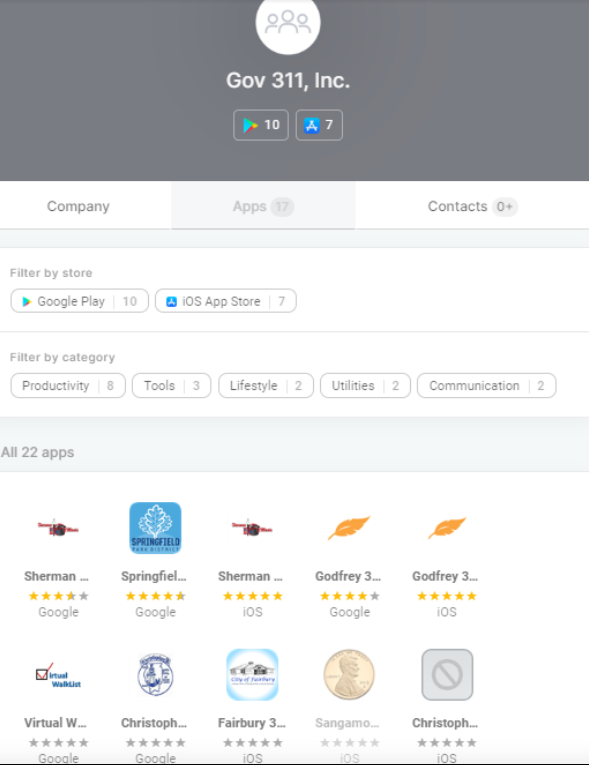 The Illinois apps that bundled Pushwoosh’s technology were produced by a company called Government 311, which is owned by Bill McCarty, the current director of the Springfield Office of Budget and Management. A 2014 story in The State Journal-Register said Gov 311’s pricing was based on population, and that the app would cost around $2,500 per year for a city with approximately 25,000 people.
The Illinois apps that bundled Pushwoosh’s technology were produced by a company called Government 311, which is owned by Bill McCarty, the current director of the Springfield Office of Budget and Management. A 2014 story in The State Journal-Register said Gov 311’s pricing was based on population, and that the app would cost around $2,500 per year for a city with approximately 25,000 people.
McCarty told KrebsOnSecurity that his company stopped using Pushwoosh “years ago,” and that it now relies on its own technology to provide push notifications through its 311 apps.
But Edwards found some of the 311 apps still try to phone home to Pushwoosh, such as the 311 app for Riverton, Ill.
“Riverton ceased being a client several years ago, which [is] probably why their app was never updated to change out Pushwoosh,” McCarty explained. “We are in the process of updating all client apps and a website refresh. As part of that, old unused apps like Riverton 311 will be deleted.”
Edwards said it’s far from clear how many other state and local government apps and Web sites rely on technology that sends user data to U.S. adversaries overseas. In July, Congress introduced an amended version of the Intelligence Authorization Act for 2023, which included a new section focusing on data drawn from online ad auctions that could be used to geolocate individuals or gain other information about them.
Business Insider reports that if this section makes it into the final version — which the Senate also has to pass — the Office for the Director of National Intelligence (ODNI) will have 60 days after the Act becomes law to produce a risk assessment. The assessment will look into “the counterintelligence risks of, and the exposure of intelligence community personnel to, tracking by foreign adversaries through advertising technology data,” the Act states.
Edwards says he’s hoping those changes pass, because what he found with Pushwoosh is likely just a drop in a bucket.
“I’m hoping that Congress acts on that,” he said. “If they were to put a requirement that there’s an annual audit of risks from foreign ad tech, that would at least force people to identify and document those connections.”
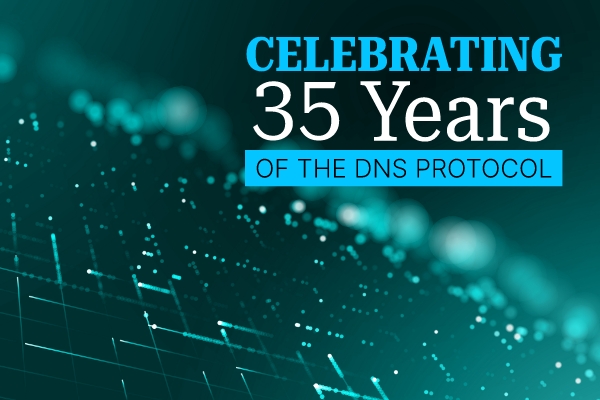
In 1987, CompuServe introduced GIF images, Steve Wozniak left Apple and IBM introduced the PS/2 personal computer with improved graphics and a 3.5-inch diskette drive. Behind the scenes, one more critical piece of internet infrastructure was quietly taking form to help establish the internet we know today.
November of 1987 saw the establishment of the Domain Name System protocol suite as internet standards. This was a development that not only would begin to open the internet to individuals and businesses globally, but also would arguably redefine communications, commerce and access to information for future generations.
Today, the DNS continues to be critical to the operation of the internet as a whole. It has a long and strong track record thanks to the work of the internet’s pioneers and the collaboration of different groups to create volunteer standards.
Let’s take a look back at the journey of the DNS over the years.
Prior to 1987, the internet was primarily used by government agencies and members of academia. Back then, the Network Information Center, managed by SRI International, manually maintained a directory of hosts and networks. While the early internet was transformative and forward-thinking, not everyone had access to it.
During that same time period, the U.S. Advanced Research Projects Agency Network, the forerunner to the internet we know now, was evolving into a growing network environment, and new naming and addressing schemes were being proposed. Seeing that there were thousands of interested institutions and companies wanting to explore the possibilities of networked computing, a group of ARPA networking researchers realized that a more modern, automated approach was needed to organize the network’s naming system for anticipated rapid growth.
Two Request for Comments documents, numbered RFC 1034 and RFC 1035, were published in 1987 by the informal Network Working Group, which soon after evolved into the Internet Engineering Task Force. Those RFCs, authored by computer scientist Paul V. Mockapetris, became the standards upon which DNS implementations have been built. It was Mockapetris, inducted into the Internet Hall of Fame in 2012, who specifically suggested a name space where database administration was distributed but could also evolve as needed.
In addition to allowing organizations to maintain their own databases, the DNS simplified the process of connecting a name that users could remember with a unique set of numbers – the Internet Protocol address – that web browsers needed to navigate to a website using a domain name. By not having to remember a seemingly random string of numbers, users could easily get to their intended destination, and more people could access the web. This has worked in a logical way for all internet users – from businesses large and small to everyday people – all around the globe.
With these two aspects of the DNS working together – wide distribution and name-to-address mapping – the DNS quickly took shape and developed into the system we know today.
Thirty-five years of DNS development and progress is attributable to the collaboration of multiple stakeholders and interest groups – academia, technical community, governments, law enforcement and civil society, plus commercial and intellectual property interests – who continue even today to bring crucial perspectives to the table as it relates to the evolution of the DNS and the internet. These perspectives have lent themselves to critical security developments in the DNS, from assuring protection of intellectual property rights to the more recent stakeholder collaborative efforts to address DNS abuse.
Other major collaborative achievements involve the IETF, which has no formal membership roster or requirements, and is responsible for the technical standards that comprise the internet protocol suite, and the Internet Corporation for Assigned Names and Numbers, which plays a central coordination role in the bottom-up multistakeholder system governing the global DNS. Without constructive and productive voluntary collaboration, the internet as we know it simply isn’t possible.
Indeed, these cooperative efforts marshaled a brand of collaboration known today as “rough consensus.” That term, originally “rough consensus and running code,” gave rise to a more dynamic collaboration process than the “100% consensus from everyone” model. In fact, the term was adopted by the IETF in the early days of establishing the DNS to describe the formation of the dominant view of the working group and the need to quickly implement new technologies, which doesn’t always allow for lengthy discussions and debates. This approach is still in use today, proving its usefulness and longevity.
As we look back on how the DNS came to be and the processes that have kept it reliably running, it’s important to recognize the work done by the organizations and individuals that make up this community. We must also remember that the efforts continue to be powered by voluntary collaborations.
Commemorating anniversaries such as 35 years of the DNS protocol allows the multiple stakeholders and communities to pause and reflect on the enormity of the work and responsibility before us. Thanks to the pioneering minds who conceived and built the early infrastructure of the internet, and in particular to Paul Mockapetris’s fundamental contribution of the DNS protocol suite, the world has been able to establish a robust global economy that few could ever have imagined so many years ago.
The 35th anniversary of the publication of RFCs 1034 and 1035 reminds us of the contributions that the DNS has made to the growth and scale of what we know today as “the internet.” That’s a moment worth celebrating.
The post Celebrating 35 Years of the DNS Protocol appeared first on Verisign Blog.
ESET researchers spot a new ransomware campaign that goes after Ukrainian organizations and has Sandworm's fingerprints all over it
The post RansomBoggs: New ransomware targeting Ukraine appeared first on WeLiveSecurity


puppi-car-1200










I’m sure you’ve seen them — emails or messages that sound alarming and ask you to act quickly. We live in a digital world that produces hundreds of messages and alerts every day. It’s often hard to determine the validity of a suspicious message or phishing email. Whether you are an administrator, or an end-user, it can be overwhelming to accurately identify a malicious message. When in doubt, here are some questions you should ask yourself:
Is the message from a legitimate sender?
Do I normally receive messages from this person?
If there’s a link, can I tell where it’s sending me?
Attackers continue to evolve their methods, and they’re highly educated on the defenses they come up against in the wild. They’ll craft messages that do not involve any traditional indicators of compromise, such as domains, IP address, or URL links. They’ll also start their attacks by sending messages as an initial lure to establish trust, before sending an email with altered invoice or one claiming to be a helpless employee attempting to get their payroll fixed.
Phishing is a socially-based attack type, one where the threat actors focus on human behavior. When these attacks target organizations, there are multiple levels of attack at play. One that focuses on behavioral patterns and workflow, and the other centers on the victim’s emotional boundaries, such as targeting their desire to help others. You see this pattern frequently in Business Email Compromise (BEC) attacks.
Below, we’ve placed an example of a lure, which will test the victim to see if there is a means to quickly establish trust. Here, the threat actor is pretending to be the Chief Financial Officer (CFO) of the victim’s organization. If the lure is successful, then the threat actor will progress the attack, and often request sensitive records or wire transfers. Notice that in the email headers, the person pretending to be the CFO is using a Gmail account, one that was likely created just for this attack. The message is brief, stresses importance and urgency, and requests assistance, playing on the victim’s workflow and desire to help an executive or someone with authority.
The example below is a simplified one, to be sure, but the elements are legitimate. Daily, emails like this hit the inboxes of organizations globally, and the attackers only need to locate a single victim to make their efforts payout.

In the FBI / IC3 2021 Internet Crime Report, there were nearly 20,000 Business Email Compromise complaints filed, with an adjusted loss of nearly 2.4 billion dollars. While spoofing the identity of an executive is certainly one way to conduct a BEC attack, the FBI says that threat actors have started leveraging the normality of hybrid-work to target meeting platforms to establish trust and conduct their crimes. When successful, the funds from the fraudulent wire transfers are moved to crypto wallets and the funds dispersed, making recovery harder.
So as an end user what can you do to protect your organization? Be mindful anytime you receive an urgent call to action, especially when the subject involves money. If your workflow means that you regularly receive these types of requests from the specific individual, verify their identity and the validity of the request using another channel of communication, such as in person or via phone. If you do validate their identity via the phone, take care to avoid calling any numbers listed in the email.
Cisco Secure Email helps stop these types of attacks by tracking user relationships and threat techniques. These techniques often include account takeover, spoofing and many more. Using an intent-based approach allows Secure Email to detect and classify business email compromises and other attacks, so administrators are empowered to take a risk-based approach to stopping these threats.
Find out more about how Cisco Secure Email can help keep your organization safe from phishing.
We’d love to hear what you think. Ask a Question, Comment Below, and Stay Connected with Cisco Secure on social!
Cisco Secure Social Channels
AMLBot, a service that helps businesses avoid transacting with cryptocurrency wallets that have been sanctioned for cybercrime activity, said an investigation published by KrebsOnSecurity last year helped it shut down three dark web services that secretly resold its technology to help cybercrooks avoid detection by anti-money laundering systems.
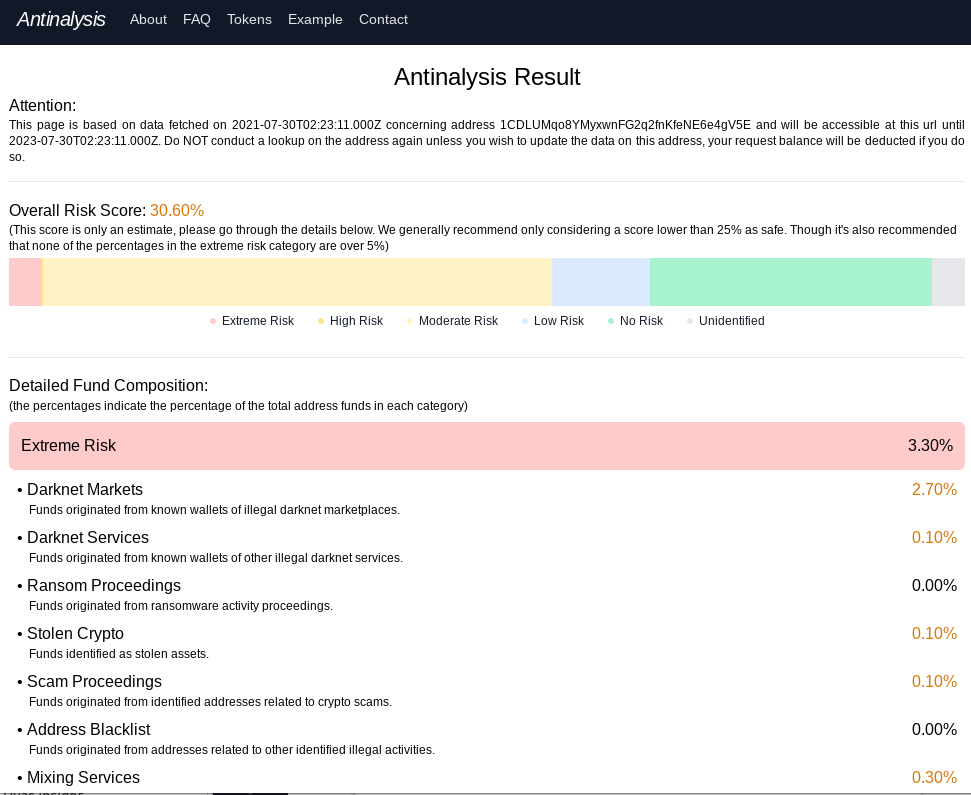
Antinalysis, as it existed in 2021.
In August 2021, KrebsOnSecurity published “New Anti Anti-Money Laundering Services for Crooks,” which examined Antinalysis, a service marketed on cybercrime forums that purported to offer a glimpse of how one’s payment activity might be flagged by law enforcement agencies and private companies that track and trace cryptocurrency transactions.
“Worried about dirty funds in your BTC address? Come check out Antinalysis, the new address risk analyzer,” read the service’s opening announcement. “This service is dedicated to individuals that have the need to possess complete privacy on the blockchain, offering a perspective from the opponent’s point of view in order for the user to comprehend the possibility of his/her funds getting flagged down under autocratic illegal charges.”
Antinalysis allows free lookups, but anyone wishing to conduct bulk look-ups has to pay at least USD $3, with a minimum $30 purchase. Other plans go for as high as $6,000 for 5,000 requests. Nick Bax, a security researcher who specializes in tracing cryptocurrency transactions, told KrebsOnSecurity at the time that Antinalysis was likely a clone of AMLBot because the two services generated near-identical results.
AMLBot shut down Antinalysis’s access just hours after last year’s story went live. However, Antinalysis[.]org remains online and accepting requests, as does the service’s Tor-based domain, and it is unclear how those services are sourcing their information.
AMLBot spokesperson Polina Smoliar said the company undertook a thorough review after that discovery, and in the process found two other services similar to Antinalysis that were reselling their application programming interface (API) access to cybercrooks.
Smoliar said that following the revelations about Antinalysis, AMLBot audited its entire client base, and implemented the ability to provide APIs only after a contract is signed and the client has been fully audited. AMLBot said it also instituted 24/7 monitoring of all client transactions.
“As a result of these actions, two more services with the name AML (the same as AMLBot has) were found to be involved in fraudulent schemes,” Smoliar said. “Information about the fraudsters was also sent to key market participants, and their transaction data was added to the tracking database to better combat money laundering.”
The Antinalysis homepage and chatter on the cybercrime forums indicates the service was created by a group of coders known as the Incognito Team. Tom Robinson, co-founder of the blockchain intelligence firm Elliptic, said the creator of Antinalysis is also one of the developers of Incognito Market, a darknet marketplace specializing in the sale of narcotics.
“Incognito was launched in late 2020, and accepts payments in both Bitcoin and Monero, a cryptoasset offering heightened anonymity,” Robinson said. “The launch of Antinalysis likely reflects the difficulties faced by the market and its vendors in cashing out their Bitcoin proceeds.”
Microsoft today released updates to fix at least 85 security holes in its Windows operating systems and related software, including a new zero-day vulnerability in all supported versions of Windows that is being actively exploited. However, noticeably absent from this month’s Patch Tuesday are any updates to address a pair of zero-day flaws being exploited this past month in Microsoft Exchange Server.

The new zero-day flaw– CVE-2022-41033 — is an “elevation of privilege” bug in the Windows COM+ event service, which provides system notifications when users logon or logoff. Microsoft says the flaw is being actively exploited, and that it was reported by an anonymous individual.
“Despite its relatively low score in comparison to other vulnerabilities patched today, this one should be at the top of everyone’s list to quickly patch,” said Kevin Breen, director of cyber threat research at Immersive Labs. “This specific vulnerability is a local privilege escalation, which means that an attacker would already need to have code execution on a host to use this exploit. Privilege escalation vulnerabilities are a common occurrence in almost every security compromise. Attackers will seek to gain SYSTEM or domain-level access in order to disable security tools, grab credentials with tools like Mimkatz and move laterally across the network.
Indeed, Satnam Narang, senior staff research engineer at Tenable, notes that almost half of the security flaws Microsoft patched this week are elevation of privilege bugs.
Some privilege escalation bugs can be particularly scary. One example is CVE-2022-37968, which affects organizations running Kubernetes clusters on Azure and earned a CVSS score of 10.0 — the most severe score possible.
Microsoft says that to exploit this vulnerability an attacker would need to know the randomly generated DNS endpoint for an Azure Arc-enabled Kubernetes cluster. But that may not be such a tall order, says Breen, who notes that a number of free and commercial DNS discovery services now make it easy to find this information on potential targets.
Late last month, Microsoft acknowledged that attackers were exploiting two previously unknown vulnerabilities in Exchange Server. Paired together, the two flaws are known as “ProxyNotShell” and they can be chained to allow remote code execution on Exchange Server systems.
Microsoft said it was expediting work on official patches for the Exchange bugs, and it urged affected customers to enable certain settings to mitigate the threat from the attacks. However, those mitigation steps were soon shown to be ineffective, and Microsoft has been adjusting them on a daily basis nearly each day since then.
The lack of Exchange patches leaves a lot of Microsoft customers exposed. Security firm Rapid7 said that as of early September 2022 the company observed more than 190,000 potentially vulnerable instances of Exchange Server exposed to the Internet.
“While Microsoft confirmed the zero-days and issued guidance faster than they have in the past, there are still no patches nearly two weeks out from initial disclosure,” said Caitlin Condon, senior manager of vulnerability research at Rapid7. “Despite high hopes that today’s Patch Tuesday release would contain fixes for the vulnerabilities, Exchange Server is conspicuously missing from the initial list of October 2022 security updates. Microsoft’s recommended rule for blocking known attack patterns has been bypassed multiple times, emphasizing the necessity of a true fix.”
Adobe also released security updates to fix 29 vulnerabilities across a variety of products, including Acrobat and Reader, ColdFusion, Commerce and Magento. Adobe said it is not aware of active attacks against any of these flaws.
For a closer look at the patches released by Microsoft today and indexed by severity and other metrics, check out the always-useful Patch Tuesday roundup from the SANS Internet Storm Center. And it’s not a bad idea to hold off updating for a few days until Microsoft works out any kinks in the updates: AskWoody.com usually has the lowdown on any patches that may be causing problems for Windows users.
As always, please consider backing up your system or at least your important documents and data before applying system updates. And if you run into any problems with these updates, please drop a note about it here in the comments.
How do organizations earn and build trust when it comes to the personal data that customers share with them? Customers certainly expect these organizations to comply with all privacy laws that are now in place in more than 130 countries. Customers also expect them not to sell personal data without consent and to try to avoid data breaches that could expose personal data. While these actions are necessary, organizations still need to do more when it comes to customer trust. According to our latest research, consumers’ top priority is, in fact, for organizations to be more transparent about how they use personal data.
The Cisco 2022 Consumer Privacy Survey, released today, explores what organizations can do to earn and build trust with customers, the actions individuals are taking to protect their data, the impact of privacy laws around the world, and some of the benefits and costs of Artificial Intelligence (AI) and data localization requirements. The report, our fourth annual look at consumer privacy issues, draws on anonymous responses from 2600 adults in 12 countries.
Here are some highlights from the survey:
Check out the associated infographic that provides visual and easily consumable descriptions of the key data.
At Cisco, we believe that privacy is a fundamental human right. Privacy continues to be a high priority for consumers, and organizations need to do their part to protect personal data and build consumer confidence in how this data is being used. Some recommendations for organizations include:
Privacy remains a critical element of trust. Consumers want more transparency and control of their personal data, especially as we continue to see innovations in technology. As we are now in the midst of Cybersecurity Awareness Month in the US and other countries around the world, it’s a great time to learn more and join in activities and discussions that advance cybersecurity.
We’d love to hear what you think. Ask a Question, Comment Below, and Stay Connected with Cisco Secure on social!
Cisco Secure Social Channels

One of the oldest tricks in the cybercrime playbook is phishing. It first hit the digital scene in 1995, at a time when millions flocked to America Online (AOL) every day. And if we know one thing about cybercriminals, it’s that they tend to follow the masses. In earlier iterations, phishing attempts were easy to spot due to link misspellings, odd link redirects, and other giveaways. However, today’s phishing tricks have become personalized, advanced, and shrouded in new disguises. So, let’s take a look at some of the different types, real-world examples and how you can recognize a phishing lure.
Every day, users get sent thousands of emails. Some are important, but most are just plain junk. These emails often get filtered to a spam folder, where phishing emails are often trapped. But sometimes they slip through the digital cracks, into a main inbox. These messages typically have urgent requests that require the user to input sensitive information or fill out a form through an external link. These phishing emails can take on many personas, such as banking institutions, popular services, and universities. As such, always remember to stay vigilant and double-check the source before giving away any information.
A sort of sibling to email phishing, link manipulation is when a cybercriminal sends users a link to malicious website under the ruse of an urgent request or deadline. After clicking on the deceptive link, the user is brought to the cybercriminal’s fake website rather than a real or verified link and asked to input or verify personal details. This exact scenario happened last year when several universities and businesses fell for a campaign disguised as a package delivery issue from FedEx. This scheme is a reminder that anyone can fall for a cybercriminals trap, which is why users always have to careful when clicking, as well as ensure the validity of the claim and source of the link. To check the validity, it’s always a good idea to contact the source directly to see if the notice or request is legitimate.
Corporate executives have always been high-level targets for cybercriminals. That’s why C-suite members have a special name for when cybercriminals try to phish them – whaling. What sounds like a silly name is anything but. In this sophisticated, as well as personalized attack, a cybercriminal attempts to manipulate the target to obtain money, trade secrets, or employee information. In recent years, organizations have become smarter and in turn, whaling has slowed down. Before the slowdown, however, many companies were hit with data breaches due to cybercriminals impersonating C-suite members and asking lower-level employees for company information. To avoid this pesky phishing attempt, train C-suite members to be able to identify phishing, as well as encourage unique, strong passwords on all devices and accounts.
Just as email spam and link manipulation are phishing siblings, so too are whaling and spear-phishing. While whaling attacks target the C-suite of a specific organization, spear-phishing rather targets lower-level employees of a specific organization. Just as selective and sophisticated as whaling, spear-phishing targets members of a specific organization to gain access to critical information, like staff credentials, intellectual property, customer data, and more. Spear-phishing attacks tend to be more lucrative than a run-of-the-mill phishing attack, which is why cybercriminals will often spend more time crafting and obtaining personal information from these specific targets. To avoid falling for this phishing scheme, employees must have proper security training so they know how to spot a phishing lure when they see one.
With so many things to click on a website, it’s easy to see why cybercriminals would take advantage of that fact. Content spoofing is based on exactly that notion – a cybercriminal alters a section of content on a page of a reliable website to redirect an unsuspecting user to an illegitimate website where they are then asked to enter personal details. The best way to steer clear of this phishing scheme is to check that the URL matches the primary domain name.
When users search for something online, they expect reliable resources. But sometimes, phishing sites can sneak their way into legitimate results. This tactic is called search engine phishing and involves search engines being manipulated into showing malicious results. Users are attracted to these sites by discount offers for products or services. However, when the user goes to buy said product or service, their personal details are collected by the deceptive site. To stay secure, watch out for potentially sketchy ads in particular and when in doubt always navigate to the official site first.
With new technologies come new avenues for cybercriminals to try and obtain personal data. Vishing, or voice phishing, is one of those new avenues. In a vishing attempt, cybercriminals contact users by phone and ask the user to dial a number to receive identifiable bank account or personal information through the phone by using a fake caller ID. For example, just last year, a security researcher received a call from their financial institution saying that their card had been compromised. Instead of offering a replacement card, the bank suggested simply blocking any future geographic-specific transactions. Sensing something was up, the researcher hung up and dialed his bank – they had no record of the call or the fraudulent card transactions. This scenario, as sophisticated as it sounds, reminds users to always double-check directly with businesses before sharing any personal information.
As you can see, phishing comes in all shapes and sizes. This blog only scratches the surface of all the ways cybercriminals lure unsuspecting users into phishing traps. The best way to stay protected is to invest in comprehensive security and stay updated on new phishing scams.
The post The Seven Main Phishing Lures of Cybercriminals appeared first on McAfee Blog.

When U.S. consumers have their online bank accounts hijacked and plundered by hackers, U.S. financial institutions are legally obligated to reverse any unauthorized transactions as long as the victim reports the fraud in a timely manner. But new data released this week suggests that for some of the nation’s largest banks, reimbursing account takeover victims has become more the exception than the rule.
The findings came in a report released by Sen. Elizabeth Warren (D-Mass.), who in April 2022 opened an investigation into fraud tied to Zelle, the “peer-to-peer” digital payment service used by many financial institutions that allows customers to quickly send cash to friends and family.
Zelle is run by Early Warning Services LLC (EWS), a private financial services company which is jointly owned by Bank of America, Capital One, JPMorgan Chase, PNC Bank, Truist, U.S. Bank, and Wells Fargo. Zelle is enabled by default for customers at over 1,000 different financial institutions, even if a great many customers still don’t know it’s there.
Sen. Warren said several of the EWS owner banks — including Capital One, JPMorgan and Wells Fargo — failed to provide all of the requested data. But Warren did get the requested information from PNC, Truist and U.S. Bank.
“Overall, the three banks that provided complete data sets reported 35,848 cases of scams, involving over $25.9 million of payments in 2021 and the first half of 2022,” the report summarized. “In the vast majority of these cases, the banks did not repay the customers that reported being scammed. Overall these three banks reported repaying customers in only 3,473 cases (representing nearly 10% of scam claims) and repaid only $2.9 million.”
Importantly, the report distinguishes between cases that involve straight up bank account takeovers and unauthorized transfers (fraud), and those losses that stem from “fraudulently induced payments,” where the victim is tricked into authorizing the transfer of funds to scammers (scams).
A common example of the latter is the Zelle Fraud Scam, which uses an ever-shifting set of come-ons to trick people into transferring money to fraudsters. The Zelle Fraud Scam often employs text messages and phone calls spoofed to look like they came from your bank, and the scam usually relates to fooling the customer into thinking they’re sending money to themselves when they’re really sending it to the crooks.
Here’s the rub: When a customer issues a payment order to their bank, the bank is obligated to honor that order so long as it passes a two-stage test. The first question asks, Did the request actually come from an authorized owner or signer on the account? In the case of Zelle scams, the answer is yes.
Trace Fooshee, a strategic advisor in the anti money laundering practice at Aite-Novarica, said the second stage requires banks to give the customer’s transfer order a kind of “sniff test” using “commercially reasonable” fraud controls that generally are not designed to detect patterns involving social engineering.
Fooshee said the legal phrase “commercially reasonable” is the primary reason why no bank has much — if anything — in the way of controlling for scam detection.
“In order for them to deploy something that would detect a good chunk of fraud on something so hard to detect they would generate egregiously high rates of false positives which would also make consumers (and, then, regulators) very unhappy,” Fooshee said. “This would tank the business case for the service as a whole rendering it something that the bank can claim to NOT be commercially reasonable.”
Sen. Warren’s report makes clear that banks generally do not pay consumers back if they are fraudulently induced into making Zelle payments.
“In simple terms, Zelle indicated that it would provide redress for users in cases of unauthorized transfers in which a user’s account is accessed by a bad actor and used to transfer a payment,” the report continued. “However, EWS’ response also indicated that neither Zelle nor its parent bank owners would reimburse users fraudulently induced by a bad actor into making a payment on the platform.”
Still, the data suggest banks did repay at least some of the funds stolen from scam victims about 10 percent of the time. Fooshee said he’s surprised that number is so high.
“That banks are paying victims of authorized payment fraud scams anything at all is noteworthy,” he said. “That’s money that they’re paying for out of pocket almost entirely for goodwill. You could argue that repaying all victims is a sound strategy especially in the climate we’re in but to say that it should be what all banks do remains an opinion until Congress changes the law.”
However, when it comes to reimbursing victims of fraud and account takeovers, the report suggests banks are stiffing their customers whenever they can get away with it. “Overall, the four banks that provided complete data sets indicated that they reimbursed only 47% of the dollar amount of fraud claims they received,” the report notes.
How did the banks behave individually? From the report:
-In 2021 and the first six months of 2022, PNC Bank indicated that its customers reported 10,683 cases of unauthorized payments totaling over $10.6 million, of which only 1,495 cases totaling $1.46 were refunded to consumers. PNC Bank left 86% of its customers that reported cases of fraud without recourse for fraudulent activity that occurred on Zelle.
-Over this same time period, U.S. Bank customers reported a total of 28,642 cases of unauthorized transactions totaling over $16.2 million, while only refunding 8,242 cases totaling less than $4.7 million.
-In the period between January 2021 and September 2022, Bank of America customers reported 81,797 cases of unauthorized transactions, totaling $125 million. Bank of America refunded only $56.1 million in fraud claims – less than 45% of the overall dollar value of claims made in that time.
–Truist indicated that the bank had a much better record of reimbursing defrauded customers over this same time period. During 2021 and the first half of 2022, Truist customers filed 24,752 unauthorized transaction claims amounting to $24.4 million. Truist reimbursed 20,349 of those claims, totaling $20.8 million – 82% of Truist claims were reimbursed over this period. Overall, however, the four banks that provided complete data sets indicated that they reimbursed only 47% of the dollar amount of fraud claims they received.
Fooshee said there has long been a great deal of inconsistency in how banks reimburse unauthorized fraud claims — even after the Consumer Financial Protection Bureau (CPFB) came out with guidance on what qualifies as an unauthorized fraud claim.
“Many banks reported that they were still not living up to those standards,” he said. “As a result, I imagine that the CFPB will come down hard on those with fines and we’ll see a correction.”
Fooshee said many banks have recently adjusted their reimbursement policies to bring them more into line with the CFPB’s guidance from last year.
“So this is heading in the right direction but not with sufficient vigor and speed to satisfy critics,” he said.
Seth Ruden is a payments fraud expert who serves as director of global advisory for digital identity company BioCatch. Ruden said Zelle has recently made “significant changes to its fraud program oversight because of consumer influence.”
“It is clear to me that despite sensational headlines, progress has been made to improve outcomes,” Ruden said. “Presently, losses in the network on a volume-adjusted basis are lower than those typical of credit cards.”
But he said any failure to reimburse victims of fraud and account takeovers only adds to pressure on Congress to do more to help victims of those scammed into authorizing Zelle payments.
“The bottom line is that regulations have not kept up with the speed of payment technology in the United States, and we’re not alone,” Ruden said. “For the first time in the UK, authorized payment scam losses have outpaced credit card losses and a regulatory response is now on the table. Banks have the choice right now to take action and increase controls or await regulators to impose a new regulatory environment.”
Sen. Warren’s report is available here (PDF).

There are, of course, some versions of the Zelle fraud scam that may be confusing financial institutions as to what constitutes “authorized” payment instructions. For example, the variant I wrote about earlier this year began with a text message that spoofed the target’s bank and warned of a pending suspicious transfer.
Those who responded at all received a call from a number spoofed to make it look like the victim’s bank calling, and were asked to validate their identities by reading back a one-time password sent via SMS. In reality, the thieves had simply asked the bank’s website to reset the victim’s password, and that one-time code sent via text by the bank’s site was the only thing the crooks needed to reset the target’s password and drain the account using Zelle.
None of the above discussion involves the risks affecting businesses that bank online. Businesses in the United States do not enjoy the same fraud liability protection afforded to consumers, and if a banking trojan or clever phishing site results in a business account getting drained, most banks will not reimburse that loss.
This is why I have always and will continue to urge small business owners to conduct their online banking affairs only from a dedicated, access restricted and security-hardened device — and preferably a non-Windows machine.
For consumers, the same old advice remains the best: Watch your bank statements like a hawk, and immediately report and contest any charges that appear fraudulent or unauthorized.
With regular marketing emails from brands, businesses, and subscription services, our email accounts are more cluttered than ever. The number of daily emails exchanged globally reached an estimated 319 billion in 2021. Unfortunately, the chances that these emails were spam or junk are quite high. In fact, 45% of all email traffic came from spam emails as of December 2021.
With emails often being the preferred mode of communication for official purposes, it’s important to observe good digital hygiene with your inbox. While a cluttered inbox can be overwhelming, it can also double as a cybersecurity threat. Junk emails that contain malware or act as phishing tools are notorious for wreaking havoc in IT systems or aiding identity theft.
Are you tired of opening your inbox to a barrage of unwanted emails? Read this article to learn how to block or eliminate spam emails.
We know you didn’t sign up to be spammed by unwanted emails. So why is your inbox overflowing with spam messages? It could be one of many reasons, including:
Companies also often share information that you’ve entered during registration with other businesses. Applications for loyalty cards and discount coupons at checkout are also sources of customer information for companies. Although companies are mandated to ask permission before sharing your personal information with affiliates, users often ignore the fine print. So, how do you block these unwanted emails?
Fortunately, most email services let you block this contact or other specific email addresses by following a few simple steps. Usually, just notifying your email service that a certain sender is spamming you does the job. The process varies according to the email provider used. Read on to find out how to keep your inbox clean.
Gmail users can block spam mail using the Gmail app or web app. Follow the steps below to block emails while using the web app:
Open a message from the sender you wish to block. If you don’t have a recent email from them, search their address or name in the search box at the top of the page.
Doing this will cause all future emails from this sender to enter your spam folder. If you block someone you didn’t intend to, follow the same procedure to unblock and start receiving mail from their address.
Follow these steps to block an address using the Outlook (the new Hotmail) web app:
By marking the email as junk, Outlook filters and sends all further emails from the sender to your spam folder.
Like all other service providers, the process of blocking a sender from your Yahoo mail account is quite straightforward. Use your web app and follow these steps to get rid of junk mail from your inbox:
Alternatively, you can also block a sender from the Settings menu.
You can unblock any address by navigating to “Blocked addresses” using the same steps and unblock any ID.
To proactively block senders from your AOL Mail inbox, follow the steps below using your web browser:
Following these simple steps marks all future emails from the chosen sender as spam and sends them to the spam folder.
The Apple iOS email app on iPhone, iPad, and Mac only recently allowed unsubscribing from mailing lists. It still doesn’t let you block senders. Follow the steps detailed below to filter and unsubscribe from senders:
Flag any email as spam by forwarding the email to spam@icloud.com.
Widely used and accepted email services are a frequent target of cyberattacks. Attackers can use email to gain control or access your personal information and resources.
Securing email systems is crucial since your email might contain a lot of sensitive information, including financial documents, legal information, important personal documents, or even trade secrets.
As an email sender and receiver, you should be aware of the most common ways the service is used to infect a computer.
A general rule of thumb is to verify and review download links, forms, and email addresses of the sender before clicking on them, as they can pose significant threats to your cybersecurity. If you receive an email from someone you trust but it contains a link that you find suspicious, multiple websites can analyze URLs and files for malware.
Keeping an email system safe involves securing the servers of the client and the user. As an informal email system user, it can be hard to mitigate and manage risks posed by malicious emails on your own.
Fortunately, you can utilize McAfee+and Identity Theft Protection. McAfee ensures complete cyber protection with advanced monitoring, customized tips according to your usage, and data clean-ups. With multiple subscription plans at your disposal, you can protect yourself and your family from all kinds of cyberthreats.
The post How to Block Emails appeared first on McAfee Blog.